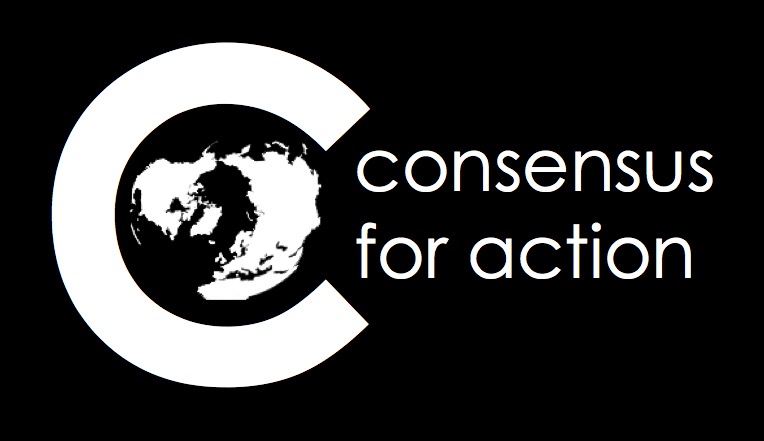ConsensusForAction Blog
Musings on the Wild: Part 5
By Anthony D. Barnosky, Professor in the Department of Integative Biology, Curator in the Museum of Paleontology, and Research Paleoecologist in the Museum of Vertebrate Zoology at the University of California, Berkeley. His new book Dodging Extinction: Power, Food, Money, and the Future of Life on Earth (University of California Press, Fall 2014) explores in more detail how people can keep wild species and wild places on Earth.
(This is the fifth of six blogs about my reflections on wild places and wild species—what they are and why they are important—written as I traveled through parts of Africa this past summer.)
Feeling Wild
My soul is at peace. That's how I know I'm in the wild.
 Maybe part of it is that it feels like
autumn, always my favorite season. Here
in Botswana's Okavango Delta, though, it's technically winter and what I'd call
an Indian summer day where I come from is occurring in late June, not late
September. Maybe part of my contentment
is because I'm sitting here in the shade, outside the little tent cabin Liz and
I are sharing, looking out on waving marsh grass, heads like feathers, but much
taller than my own six feet of humanity.
Breaks of blue-green water peek out of the grass. We're on a meander that is right on the edge
of the delta.
Maybe part of it is that it feels like
autumn, always my favorite season. Here
in Botswana's Okavango Delta, though, it's technically winter and what I'd call
an Indian summer day where I come from is occurring in late June, not late
September. Maybe part of my contentment
is because I'm sitting here in the shade, outside the little tent cabin Liz and
I are sharing, looking out on waving marsh grass, heads like feathers, but much
taller than my own six feet of humanity.
Breaks of blue-green water peek out of the grass. We're on a meander that is right on the edge
of the delta.
In the middle of the night we heard hippos splash out of the water and spend some time munching the grass right outside the canvas walls. On safari this morning, it was quiet when we killed the engine, only the sound of the breeze, birdsong, the rustling of the grass. Even the elephants were quiet, as we parked there in the midst of a herd that milled around us. I counted at least fifty; it's my guess the real number was close to a hundred.
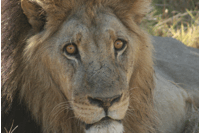 Likewise the lions we came across were
serene, resting in the shade, all three of them lazy males. Liz spotted them there in the tall grass, two
of them sprawled out sound asleep, the other one with his paws stretched out in
front, hind quarters cocked to the side, head up, quietly watching us watch
him. Crocodile on the bank, fish eagle
in the tree, pelicans and flamingoes herding fish in a drying out pond. Nobody seemed to have a care in the world.
Though I suspect the fish did.
Likewise the lions we came across were
serene, resting in the shade, all three of them lazy males. Liz spotted them there in the tall grass, two
of them sprawled out sound asleep, the other one with his paws stretched out in
front, hind quarters cocked to the side, head up, quietly watching us watch
him. Crocodile on the bank, fish eagle
in the tree, pelicans and flamingoes herding fish in a drying out pond. Nobody seemed to have a care in the world.
Though I suspect the fish did.
The other thing is the smells. At one point there was sage—sweeter than the sagebrush I'm used to, but familiar enough to make me feel good. Marsh mud, not strong, tempered by the hay-smell of drying grass. And unfamiliar, yet familiar: animals, different kinds, that had recently gone by, and more pungent yet (but in a good way), the earthy smell of elephant droppings.
Getting here is not all that easy, and I'm sure that's one of the things that makes it my kind of wild. We took the quickest route, a thirty-minute flight from Maun in a seven-seat bush plane. From our vantage it was easy to see why driving to the Okavango from our takeoff point would entail six to eight hours in the best of conditions, much of it on a two rut road, and a couple of days if the water is running high, even though it's only an 80 mile drive, give or take.
 We're here when the water is fairly high.
The rainy season in Angola stopped more than a month ago, but it's taken all
this time for the water to finally make its way along the Namibian border and
spread out in a broad fan here, where tectonic warping has dropped the land
surface a little lower than up north.
From our bird’s eye view, the result looks like loosely braided blue-black
ribbons, which are actually of water.
Between each of the watery strands are islands and strips of land, some
big, some small, but all of them with their concentric bands of bright green
next to the water giving way to golden brown a little higher up where the
grasses have already dried, to deeper forest or olive green in the places where
the trees never get drowned. As the
season goes on we're told, the bands of brown get wider, and the bright green
marshy areas and blue water begin to disappear under the relentless African
summer sun.
We're here when the water is fairly high.
The rainy season in Angola stopped more than a month ago, but it's taken all
this time for the water to finally make its way along the Namibian border and
spread out in a broad fan here, where tectonic warping has dropped the land
surface a little lower than up north.
From our bird’s eye view, the result looks like loosely braided blue-black
ribbons, which are actually of water.
Between each of the watery strands are islands and strips of land, some
big, some small, but all of them with their concentric bands of bright green
next to the water giving way to golden brown a little higher up where the
grasses have already dried, to deeper forest or olive green in the places where
the trees never get drowned. As the
season goes on we're told, the bands of brown get wider, and the bright green
marshy areas and blue water begin to disappear under the relentless African
summer sun.
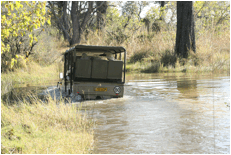 The fluctuating water levels and deep sand
it leaves behind are why there are few roads into this place, and of those
there are, why parts of them are submerged by water and impassable for much of
the year. Even now, it can be touch and
go. This morning we dipped our land rover nose-deep into a couple of ponds the
road runs through, and I wasn't all that sure we'd make it to other side. We always did, but not so for two other
vehicles in our party, who apparently spent much of their morning stuck in a
thigh-deep water crossing. Where there
wasn't water on the road, the sand can make travel tricky—in
one place this morning, our wheels just spun, land rover stationary, sand
flying, in a maneuver that got us going, but just as easily could have dug us
down to our axle.
The fluctuating water levels and deep sand
it leaves behind are why there are few roads into this place, and of those
there are, why parts of them are submerged by water and impassable for much of
the year. Even now, it can be touch and
go. This morning we dipped our land rover nose-deep into a couple of ponds the
road runs through, and I wasn't all that sure we'd make it to other side. We always did, but not so for two other
vehicles in our party, who apparently spent much of their morning stuck in a
thigh-deep water crossing. Where there
wasn't water on the road, the sand can make travel tricky—in
one place this morning, our wheels just spun, land rover stationary, sand
flying, in a maneuver that got us going, but just as easily could have dug us
down to our axle.
The lack of roads into and through this area is one aspect that makes it feel wild—indeed, actually makes it wild. But the Okavango Delta also blends the two other characteristics I've come to realize define wild for me: not only landscapes untamed by people, but in those landscapes, animals untamed by people. My wild has to have both.
And the Okavango Delta does. The delta does what it wants: when the river is high, the going gets tough, and when the river is low, things get easier, for people anyway. My point is that we don't control this river—it does what it wants. The river controls us. Likewise, nobody is controlling the animals that live here. They come and go as they have for millennia, with the rhythms of the river and the seasons. No fences in sight, once you leave the camps.
 The animals seem not too worried by
humans, but they don't seem tame. It's more like a tacit understanding between
the animals and people—you don't mess with us, we won't mess with you. I'm willing to bet it's pretty much the same
tacit understanding that has existed between people and the animals here since Homo
sapiens evolved. Maybe it's not too
different from whatever signal the lions we saw today were giving to the herd
of impalas that were also in our sightline:
don't sweat it impalas, too lazy to hunt right now, but don't let your
guard down.
The animals seem not too worried by
humans, but they don't seem tame. It's more like a tacit understanding between
the animals and people—you don't mess with us, we won't mess with you. I'm willing to bet it's pretty much the same
tacit understanding that has existed between people and the animals here since Homo
sapiens evolved. Maybe it's not too
different from whatever signal the lions we saw today were giving to the herd
of impalas that were also in our sightline:
don't sweat it impalas, too lazy to hunt right now, but don't let your
guard down.
I used to think that Paul Martin's old explanation of why megafauna survived in Africa, while succumbing to human pressures most everywhere else, was pretty ad hoc. He thought that since humans and the big animals evolved together in Africa, they reached some ecological arrangement early on that basically said live and let live, except when you were hungry enough. Maybe he wasn't so far off though—that's sure what the lions were saying to the impalas today.
Sitting here in the afternoon sun it's seeming less and less farfetched to me that early humans slotted into the overall ecosystem the same way. Surely, that's the message we got, and gave, to dozens of wild species this morning.
It's ironic. It's solace, and it's peaceful, but it's wild.
Musings on the Wild: Part 4
By Anthony D. Barnosky, Professor in the Department of Integative Biology, Curator in the Museum of Paleontology, and Research Paleoecologist in the Museum of Vertebrate Zoology at the University of California, Berkeley. His new book Dodging Extinction: Power, Food, Money, and the Future of Life on Earth (University of California Press, Fall 2014) explores in more detail how people can keep wild species and wild places on Earth.
The Mighty Zambezi
It's not Victoria Falls, or the Zambezi River around here. It's the MIGHTY Victoria Falls, and the MIGHTY Zambezi River. The why of that is pretty obvious when you see the falls, but that comes later. First we hopped on a small boat and went upriver a ways. The safety instructions were pretty casual, and life jackets weren't a part of the program. Much more critical was the location of the anchor. Which makes sense, I guess, when you consider we were only a mile or so above the falls.
You wouldn't want to go over them, of course, so in case of trouble, say, a stalled motor, you'd want to drop that anchor fast. If you didn't, your fate would be the same as befalls the occasional elephant or hippo who gets caught in a stronger current than they were counting on as they try to swim to or from one of the many islands that pepper the mighty Zambezi: a fast ride to a very watery grave. The other essential part of the safety lecture involved knowing where the liquor was: Mosi beer, gin, whiskey. Drink your fill, we were told, and then our boatman pointed the bow upstream and we were on the way.
This was a different take on the wild. Elegant hotels on the Zambia side, and I presume the same across the river in Zimbabwe, but in the river and on its islands, crocodiles, monitor lizards, hippos, elephants. Somehow, those river-bound animals seemed wilder than most of what we'd seen in the South African game reserve. They were more shy, for one thing. Some of them seemed a little crabbier—we hightailed it out of one area when a hippo took offense at us, first lifting his backside out of the water and cranking his tail like a propeller to spread his feces in order to mark his territory. Then he disappeared under water, and surfaced at our stern heading our way. Or maybe he was just cranky with the elephants chomping down the tall grass on the marshy island, grass he was probably hoping to eat that evening.
The crocodiles seemed for the most part unfazed by us, or anything else, although a couple of them did slip into the water as we approached. That made it pretty clear why lifejackets weren't really a big part of the safety program. Maybe too that's why we were encouraged to drink our fill. If you go overboard in these waters, there would be certain advantages to being appropriately anesthetized.
I got the feeling that the river ruled these islands, not people. It's a force of nature clearly beyond our control—at least in stretches like that part of the Zambezi we were on, that still respond to the ebb and flow the moisture falling hundreds of miles upstream in their drainage basins, and that have not yet been tamed by a dam. So I'm thinking that to really be "wild," a place has to have a big element of untamed, by which I mean, cannot be controlled by people.
Or at least, people's control has to be a lot less than what is out of their control.
That is definitely the case for the mighty Victoria Falls themselves. A walk along the rim makes that readily apparent. The first thing you see is the mist; actually, you see that from miles away, but when you get close, it's mist and double rainbows. Further into the cloud of spray, the water crashing over the lip of the basalt precipice becomes visible and as you sweep your gaze to the left, you see more, and more, and more foamy white wall, but you never see the other side. It goes on out of your line of sight. Farther along the trail, you run into the most intense rainstorm you'll ever walk through, but it's not rain. It's the mist from the falls, and you keep getting drenched for several hundred yards. What goes up must come down, and what's coming down are sheets of water drops falling from the blue sky. I'm soaked to the skin in seconds, but it feels good. This is all engulfing. The only sound is the roar of the falls.
Click the picture to hear the roar of the falls (QuickTime Required)
That's wild, but it's not alive. So for me, it's not totally wild, because wild means wild living things as part of the landscape too. There are no big cats on the Zambia side—we're assured they've all been "taken care of." We're safe.
Actually though, there are big cats, but well confined as money makers for an outfit that provides the opportunity for interlopers like me to "walk with the lions." I couldn't bring myself to do that. It just seemed wrong, to go against my grain. Not least of which because the lions are "orphans." I mean, just how many ways can a lion cub become an orphan, without the intervening hand of man?
That's just me though. Several in our group bought tickets and not only walked with the lions, but also petted them (only on the back though; apparently you are supposed to stay away from their ticklish ears and heads). They loved it, and I suspect I would have too. Before they went, I asked a couple of them to find out what happens to the lions after they get too big to "walk with," when they begin to get close to full grown. The report is that the orphans at that point are taught to find their own food increasingly without human help, and when they are ready, they are placed back into the "wild," in places where lion populations are in trouble. Which of course theoretically would give a wide choice of areas to place them.
That is a rosy picture, and I hope it's true. If so, I'm ok with it, I guess. The lions help local people make a living, and the local people help lions stay on Earth. I think I'd want to run down exactly where those orphan lions come from though, and where they end up. While here we've also been told of lion "farms" that raise the animals to adulthood in order to drop them into big-game hunting preserves, a misnomer in my mind, in that the animals are bought and paid for in advance, and the hunter is led to the right place to execute it. That too helps keep lions on Earth, in an odd way. I've hunted myself, and I’ve got nothing against hunting when it's a fair fight. But I don't see much difference between the canned hunting that takes place in some of those hunting preserves and leading a lamb to the slaughter.

The Zambezi River is in the background.
Photo courtesy of Elizabeth Hadly.
It's a complicated question, this business of keeping wild animals from going extinct. Our colonial-era hotel sits right on the bank of the Zambezi, so the hippos and elephants occasionally wander up onto the nicely manicured lawn. I guess they are to some extent habituated to people, but they're still the boss. That's a step up from the zebras and giraffes that roam the property, which eat out of troughs the grounds keepers fill.
So there you have it. This area around the mighty Victoria Falls is wild in the river, and tame on the bank. It's one way for people to share common ground with some other big animals that are vulnerable to extinction. Game reserves like the one we came from in South Africa are another. But the problem for me is, those solutions make my version of the wild a thing of the past.
I want a version of wild that feels wild.
(Next week: the Okavango Delta in Botswana.)
Musings on the Wild: Part 3
By Anthony D. Barnosky, Professor in the Department of Integative Biology, Curator in the Museum of Paleontology, and Research Paleoecologist in the Museum of Vertebrate Zoology at the University of California, Berkeley. His new book Dodging Extinction: Power, Food, Money, and the Future of Life on Earth (University of California Press, Fall 2014) explores in more detail how people can keep wild species and wild places on Earth.
Peep Show
(This is the third of six blogs about my reflections on wild places and wild species—what they are and why they are important—written as I traveled through parts of Africa this past summer.)
Sitting in the Nelspruit airport waiting for a flight to Zambia, I'm still troubled about this wild thing, maybe even more so after last night. Last night we returned to the place where the leopards hang out.
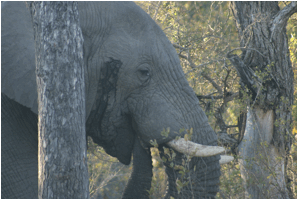 On the wild side was this: we came across that big bull elephant in rut,
seems like the same one we had the encounter with on foot a couple of days
ago. This time we were in our land
rover, but even so he was about twice our size.
He had a standoff with another land rover that was ahead of us. From a distance, we watched him glare at it,
wave his ears, stamp his foot, and then start to move forward. The land rover moved backward as fast as
prudence dictated, executed one third of a three-point turn, and headed off in
another direction. Our driver knew
enough to just sit there awhile, let the big guy turn around and amble down the
road a bit, and then we followed, keeping enough distance between us and him,
maybe fifty yards or so. Though our
prime view was of his rear end, every now and then he'd swing his head side to
side, enough to give us a clear view of a dark stripe of pungent ooze dripping
out of his musth gland.
On the wild side was this: we came across that big bull elephant in rut,
seems like the same one we had the encounter with on foot a couple of days
ago. This time we were in our land
rover, but even so he was about twice our size.
He had a standoff with another land rover that was ahead of us. From a distance, we watched him glare at it,
wave his ears, stamp his foot, and then start to move forward. The land rover moved backward as fast as
prudence dictated, executed one third of a three-point turn, and headed off in
another direction. Our driver knew
enough to just sit there awhile, let the big guy turn around and amble down the
road a bit, and then we followed, keeping enough distance between us and him,
maybe fifty yards or so. Though our
prime view was of his rear end, every now and then he'd swing his head side to
side, enough to give us a clear view of a dark stripe of pungent ooze dripping
out of his musth gland.
The bull at one point stepped off the road, put his shoulder against a tree that was three times his height and with a trunk the girth of his leg, and then began to push. You could see him strain, the tree began to bend, creak, and crackle, but it held. He tried again, same result, and then he wrapped his trunk around it and began pulling. The tree wouldn't give in though, which I guess speaks to how deep and extensive its root system must be. At last the elephant gave an audible sigh of disgust, and contented himself by reaching skyward with his trunk, wrapping it around a branch about as big around as my leg and twice as tall as me, and with one good tug he splintered it off. Then he got down to business chewing off the sweet bark, using his trunk to gently rotate it as he threaded the branch through his jaws. The portion of the branch that went in one side of his jaws was covered with rough gray bark; he'd work it with his trunk to push it sideways into the void of his mouth, and it would come out the other side clean and gleaming creamy white, kind of like de-barking a tree in a sawmill. Eventually he had enough, and resumed his slow, deliberate stroll down the road.
 On the tame side. A sundowner stop, gin and tonics, and an
orange African sunset silhouetting black
trees, their branches like intricate river networks gathering stars from the
darkening sky. Eventually the trees faded into the black of the night, the
Southern Cross lit up, and the Milky Way shone spectacularly bright.
On the tame side. A sundowner stop, gin and tonics, and an
orange African sunset silhouetting black
trees, their branches like intricate river networks gathering stars from the
darkening sky. Eventually the trees faded into the black of the night, the
Southern Cross lit up, and the Milky Way shone spectacularly bright.
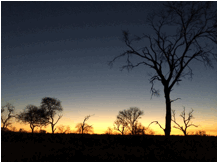
It was under that night sky we returned to the wild, or at least what initially seemed that way. Word came again on the radios: the leopards had been spotted. We were bushwhacking through dense underbrush to follow them. Three land rovers, each with their spotlights, now totally off road, crashing and snapping through the thicket where the leopards were hunting cane rats. By then in my mind, the leopards were fugitives on the run, and we were the yahoos with dogs about to put them in chains.
And then, there they were. There was no snarling, panicked attempt to get out of our spotlight beam. Instead, the male stretched out on his belly and crunched happily on a cane rat he'd just caught, not a care in in the world. The female patiently lay a few yards a way, with what I soon came to realize was a dreamy look of anticipation in her eyes.
And it wasn't anticipation for a bite of cane rat. She had something far more primal on her mind. After the male ate every last morsel, he licked the blood off his paws, going through very much the same ritual as your house cat after a meal. Suddenly he stood, and in two or three strides he was on the other side the female, whereupon he once again plopped down in the tall soft grass, head up, calmly checking us out.
As he'd gone by the female, she'd given a soft growl, something like a loud purr, but more menacing. Now she was up, brushing by the male, making body contact, giving him a good whiff of her hind end. He growled, she moved off. But in a minute or so, the same routine. Next thing we knew the male's on top, a sound like leopard laughter, he's biting the back of her neck. In less than ten seconds it’s over. We've just seen leopards mate. In the wild?
This is where it gets tricky for me. We watched three rounds of that mating routine, and we weren't the only ones. Three land rovers surrounded those leopards on one side, a tracker in each shining their bright lights on the whole event. It was eerily like the leopards were in the spotlights on a grassy stage, a thorny thicket as the backdrop. And us, and the twenty other people observing the show, we were like paparazzi, the number of camera flashes intensifying pretty much in rhythm with the fireworks presumably lighting up the leopards' synapses.
 If it all sounds a bit like the porn
version of Wild Kingdom, with us as the both film crew and audience, well,
that's pretty much what it was.
Afterwards our guide told us that those leopards have become completely
used to the land rovers over the past few years, and that the after-sun-down
chase has become about as familiar to the leopards as your evening cocktail is
to you. It's just what happens right
after the sun goes down. That wasn't too
hard to believe. Certainly the leopards
noticed us just about as much you'd notice a fly on the wall; we may as well
have been another tree as far as they were concerned.
If it all sounds a bit like the porn
version of Wild Kingdom, with us as the both film crew and audience, well,
that's pretty much what it was.
Afterwards our guide told us that those leopards have become completely
used to the land rovers over the past few years, and that the after-sun-down
chase has become about as familiar to the leopards as your evening cocktail is
to you. It's just what happens right
after the sun goes down. That wasn't too
hard to believe. Certainly the leopards
noticed us just about as much you'd notice a fly on the wall; we may as well
have been another tree as far as they were concerned.
Except right at the end. The male finally had had enough, whether of the female, or of us, I have no idea. But he rose to his feet, and walked towards our land rover. For one brief second, maybe two, he lifted his eyes and stared into ours, and in that second, it was absolutely clear that he was predator, we were prey. He suddenly turned, our tracker lifted his feet out of the way as the leopard passed under them, and then both leopards melted back into the dark. Show over.
So, did I experience the wild? Certainly it was thrilling, and probably a once in a lifetime experience. I wouldn't trade it. But wild?
Now I'm on the plane flying north towards the next destination, Victoria Falls. It's a bigger jet this time, so I'm far above the fray on the ground. I did notice as we took off though, there was a dammed river below, and they were being careful about controlling the flow: the riverbed below the dam was almost dry. All around the reservoir, flames from more-or-less controlled burns were sending their smoke to the sky, the haze largely responsible for that beautiful orange sunset I'd so much enjoyed the night before.
Reflecting on it all, two images come to mind. One is sitting on a tour bus, driving through the streets of Soweto, a world much more foreign to me than the African, or any other backcountry. I was nothing but a voyeur in Soweto, while being shown all the classic sights: the gold mine tailings, the old miners barracks, Nelson Mandela's house, the site of the 1976 tragedy when the police opened fire on marching school kids, the nicer homes that have started to spring up in post-apartheid times, and pockets of truly destitute slums, where goat pens were right next to tattered-tarp family dwellings. When we stopped for lunch there, some dancers dressed in traditional Botswana knock-off costumes performed for us.
The other image is those mating leopards. I was nothing but a voyeur there too, staring down from above in my land rover seat.
Maybe there's a difference between those two experiences, but I'm not sure yet what it is. One thing I do know. What I yearn for in the wild is being in it, not just being shown it.
Musings on the Wild: Part 2
By Anthony D. Barnosky, Professor in the Department of Integative Biology, Curator in the Museum of Paleontology, and Research Paleoecologist in the Museum of Vertebrate Zoology at the University of California, Berkeley. His new book Dodging Extinction: Power, Food, Money, and the Future of Life on Earth (University of California Press, Fall 2014) explores in more detail how people can keep wild species and wild places on Earth.
All the Same to the Weaver Birds
(This is the second of six blogs about my reflections on wild places and wild species—what they are and why they are important—written as I traveled through parts of Africa this past summer.)
We walk without talking, heading upwind. Safer that way, because you can smell the rhinos, the elephants, the lions before they smell you. The breeze is our friend, and it's talking to me, filling my world like the exhale of a lover, except it goes on forever. Well, not forever, because then my listening shifts to the sound we make walking on the sandy path.
Five of us, single file, I'm third in line. In the lead our guide has a slight limp, I think about why, maybe there's a story there, maybe it's just old bones, like mine. His crunches are uneven, one lasting slightly longer than the next, dit-dot, dit-dot. Just ahead of me Liz's feet follow one after the other in perfect rhythm, stitch stitch stitch, the symmetry of an athlete's walk. By some trick of acoustics, probably because we’re walking into the wind, I can't pick up the sound of my own feet as well as those ahead, and those behind are more muffled. I can't really distinguish whose are whose back there, though I know there are two people walking.
We hit the shin-high grass, and then we're all the same. Swish swish swish. We stop for a minute, and it's all about birdsong. A double cheep here, a longer caw there. Otherwise silence, except for our friend the breeze.
In the distance are a few zebra, hanging out with a few more impala. Right next to them is a telephone pole, right in front of them, a road. This is too weird. We shift direction as the wind does, keeping it in our noses, and in not too long we're on that road, crunching on the sand, leaving our tracks alongside those of the other animals.
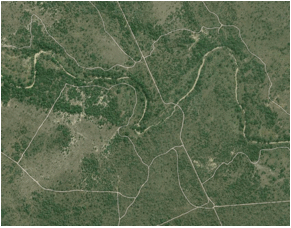
I pulled up the google maps at six o'clock this morning, before we left on our safari, and I saw that you would be hard pressed to walk very far at all around here without crossing a dirt road (you won't see pavement), though the telephone lines and cell towers are more localized. Yet on the road, we're tracking hyaena, giraffe, rhino.
(A mongoose just ran in front of me as I sit here writing. It's checking me out, the sun highlighting it's milk-chocolate back.)
Last night, just after dark, we were heading back to camp in the land rover when over the radio came news that one group had spotted a leopard. We used the dense road network I saw on my google satellite image to hightail it over to the action. Sure enough, we caught up with the two other land rovers that had been out on patrol and saw their spotlights sweeping the dense bushes. Yep, the leopards are here—not one, but two—just went off into the thickets. We smelled their pee, no doubt about it, there were big cats nearby.
The other land rovers pulled aside to give us a shot at the action, and then, right there in our tracker's spotlight, the leopards veered back onto the road, not a care in the world. Two of them, a male and a female, going about their boy-girl business, ambling in our headlight beam, with our big diesel-belching beast ambling right behind them. Those land rovers were part of their world for sure, though I suspect that if any one of us had stepped out of the truck, we wouldn't have been part of anybody's world for too long. After a hundred yards or so, the leopards turned back into the thickets, all to the tune of land rovers ahead bushwhacking overland to hopefully intercept them for a few more camera shots.
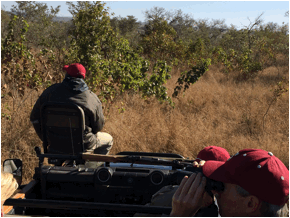
This morning, we drove back out there. It had been a cold night and was still a cold morning, and maybe because of that the animals, like us, were pretty quiet. A few impala, a few kudu, some zebra, and from a hill top where we stopped for a thermos of coffee, a wide, wide vista clear into Kruger Park. You couldn't actually see any roads from our vantage, though I knew from my map that they were certainly snaking all through that landscape, and as I sipped my coffee I pondered once again whether I was in a wild place or not.
There's no doubt people have played with this landscape, a lot. One reason there are all those roads is because in this area there are several different privately owned game reserves, just like the one we're staying at, each butting up against the next. We stay on our game roads, they stay on theirs. I was told this morning that one guy even brought in a few tigers, hoping to turn the Big Five into the Big Six (not extinctions, thankfully, here we're talking about the Big Five animals African hunters consider the most dangerous: elephants, water buffalo, rhinos, lions, and leopards). Luckily, the tigers haven't spread.
But the signs of humanity sure have, all through these game reserves, and that's affected the animals for both good and bad. You take your choice which is which. That big fence that separates the reserve lands from homelands, for instance. The lions know all about that. They drive their prey right into it. Great for the lions, of course. All those waterholes we drive by were dug out by bulldozers. Instead of a few natural waterholes where the African fauna would normally congregate, the new ones are spread out to bring animals to all the different game reserves, and even all the different parts of a given reserve. And the road network facilitates movement not only for our land rovers, but makes fast traveling for the animals too, as all those tracks show us on our bush walk.
That was a pleasant walk. It was hard not to feel like the place was wild when you were listening to the breeze, the crunch of our soles against the gravel, the swish of the dry grass against our legs, and when thinking about why our guide was carrying his rifle at the ready. But it was also hard not to notice that at some points we were walking beneath telephone wires, at others along a road, which twice we had to step off of as vehicles trundled past, their tire marks obliterating the fresh giraffe tracks.
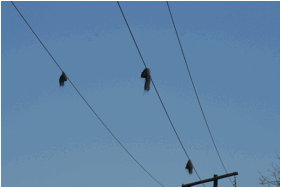
Maybe this sums it up. Hanging from the telephone wires were weaver bird nests. They've learned those wires are safer places than trees to build their nests, because no birds of prey can perch above them to swoop down at an inopportune time. So, despite the offense those telephone lines give to my eyes, it's all the same to the weaver birds, maybe even better. Same for that dense road network for many of the other animals.
So now I'm in a state of flux about what's wild. No doubt about one thing: if people disappeared from this landscape tomorrow, it would go right back to operating exactly as it has been for hundreds of thousands of years before, with pretty much the full complement of fauna and flora. Maybe that's all it takes to be wild, despite all the signs of people here.
The jury's still out for me on that one.
(Stay tuned for Part 3, in about a week.)

